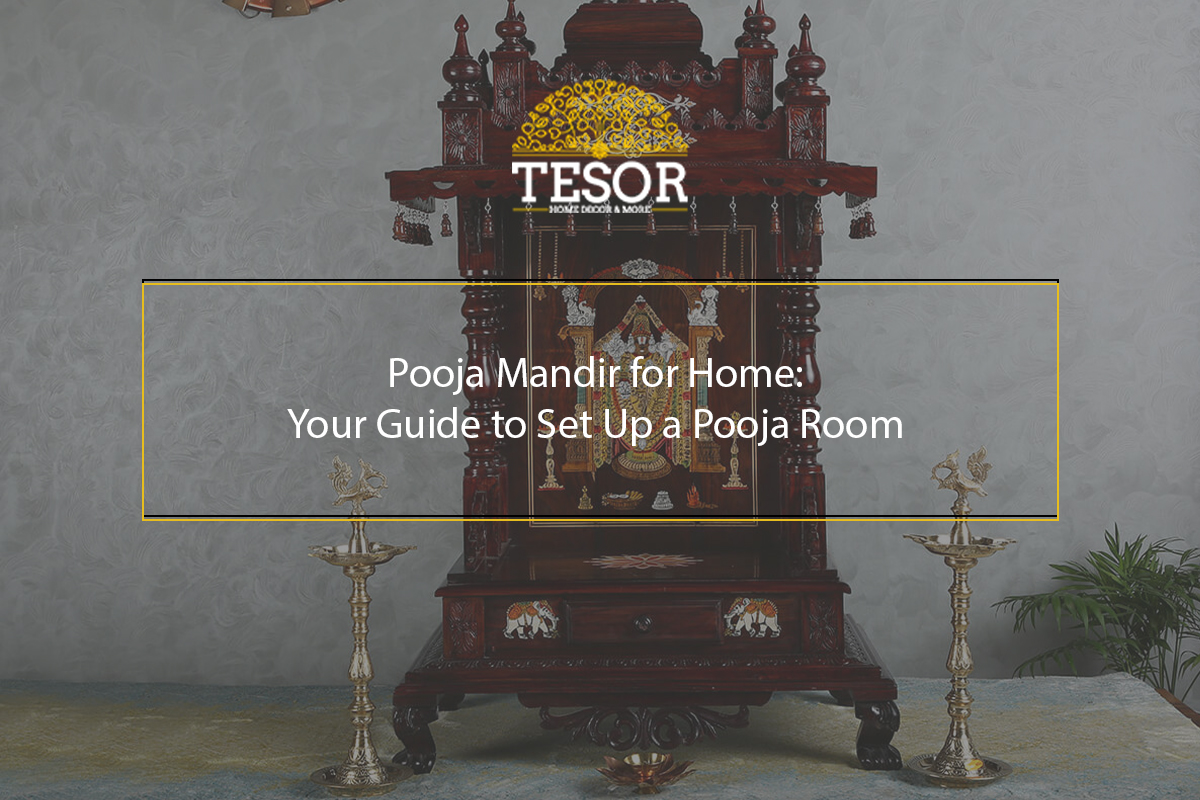
The Simplest Guide to Setting Up Your Pooja Room: Pooja Mandir for Home
Moving into a new apartment as someone who is an interior design enthusiast and pooja room owner, you will oftentimes catch yourself being confused in figuring out how to align your sacred space with your modern interior space.
All of this hassle can be simplified with a simple yet effective guide on how to set up your pooja room. In India, Vastu Shastra is highly valued as an ancient architectural science that offers guidelines to maintain energy balance in a home.
So we have curated just the right beginner’s guide for you that makes your modern decor look remarkable while going hand in hand with Vastu Shastra principles.
6 Simple and best techniques to set up your pooja room beautifully:
Creating the perfect pooja room goes beyond aesthetics, it’s about fostering a space filled with positive energy and spiritual peace. Here’s how you can achieve it!
1. Direction of the pooja room:
For a pooja room that aligns with Vastu principles, the northeast corner of the house is ideal.
Make sure to face north or east while praying. The northern or eastern sides of the house are known to be suitable for creating a sacred space that makes your home feel more homely than ever.
2. Size of the Pooja Room:
It doesn’t matter if you have a spacious home or a compact one, you can make any space feel sacred, irrespective of their size. If you happen to have a spacious home, consider a separate room dedicated to keeping your mandir. In open-plan homes, you can reserve a spot to build a raised platform or a semi-open partition for your pooja mandir.
However, for smaller spaces, a freestanding pooja unit, a converted niche, or the famous wall-mounted unit can serve as perfect alternatives.
3. Praying Habits:
Your prayer routine is crucial in determining the setup of your pooja room. If your family gathers daily for prayer, ensure the space accommodates everyone comfortably. For less frequent prayers, set aside a space and check where you’ll stand or sit during rituals.
Need a quick tip? A good rule of thumb is to place the deity’s base at 1 foot 6 inches from the ground, allowing you to pray comfortably, whether standing or seated.
4. Choose your material:
Marble has been a timeless piece to enhance a mandir’s look, however, you can also explore other materials like wood. You can choose your preferred wood tone and type that creates the desired serene and inviting atmosphere for your pooja room.
5. Install Good Lighting:
Lighting sets the mood in your pooja room, giving your guests a welcoming and warm feeling as they enter. Recessed ceiling lights combined with a crystal chandelier can add a touch of luxury. Besides that, a pendant light that casts intricate patterns on the walls and floor is a great way to illuminate this sacred space.
6. Accessorize Thoughtfully:
Accessorizing is key to making your pooja rooms stand out and accomplishing a finished look! Add temple bells, prayer mats, a holy basil plant, and religious symbols. Try not to go overboard, keep the space uncluttered and avoid overcrowding with too many deities and idols.
Pro tip: Fresh flowers like marigolds or roses are a beautiful offering to the deities, they add a refreshing feeling and beauty to the room. Always remember to replace wilted flowers regularly to maintain a vibrant and auspicious atmosphere.
What to avoid in your pooja room?
- Avoid storing items unrelated to pooja samagri in your mandir.
- Do not place your pooja unit in the south direction, as it is considered inauspicious.
- Avoid setting up the pooja space in storerooms, kitchens, or bathroom zones.
- Do not place a dustbin in the room, as it has the potential to reduce positive energy.
- Discard any damaged idols and photos from the unit.
- Finally, make sure to avoid excessive fabric around diyas to prevent any safety hazards.
You might want to check out our exceptional range of brass idols for your pooja mandir!
Find the most uniquely designed Pooja Mandir for your home only at Tesor:
By now we’re sure you are confident enough to set up your pooja room all on your own! We understand how important it is for you to create a serene and spiritual pooja room in your home. That’s why Tesor is the one to choose!
At Tesor, you can get your hands on the most beautifully designed and affordable pooja mandirs that can become a sanctuary of peace and devotion!
So what are you waiting for? Visit Tesor today or check out our website to elevate your home’s sacred space with our exceptional craftsmanship.
FAQs (Frequently Asked Questions):
1. How to Set Up a Pooja Room at Home?
When setting up a pooja room, it’s important to place the mandir in such a way that the doors and windows open towards the north or east direction.
2. What is the Ideal Position for the Pooja Room?
The northeast is considered the most auspicious direction for a Pooja room, as it is associated with the sacred zone of Lord Shiva. If that’s not feasible for you, then you can consider positioning your pooja room towards the east or north side.
3. Can We Keep Two Mandirs at Home?
Yes, you can have two mandirs at home, but make sure to treat and maintain them equally, while ensuring there’s enough space for all your idols and pooja materials. Regularly clean both mandirs and perform rituals to preserve harmony and prevent any feeling of neglect.
4. Which Idol Should Be Kept in the Pooja Room?
Brass idols are recommended to keep in pooja mandirs for home because they symbolize durability and tradition. They also add a spiritual ambiance to the space while being easy to maintain.
5. How to Organize a Mandir at Home?
There are many things to keep in mind while organizing a mandir at home. The first thing to keep in mind is the positioning of the idol. Place the idols in such a way that they face either north or east, and the person praying should also face one of these directions. Avoid having idols face each other, and leave a gap between the wall and the idols. Maintain a clean and clutter-free space to foster a positive ambiance.





